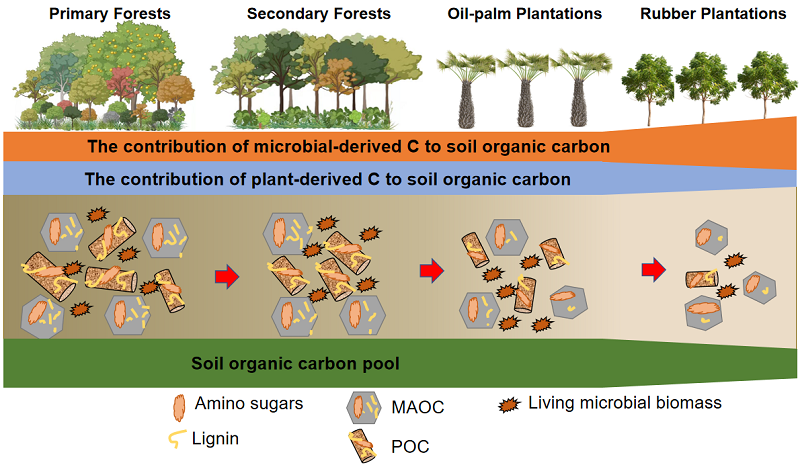

Plant- (e.g. lignin) and microbial-derived (e.g. microbial necromass) metabolic products are important sources of soil organic carbon (SOC) pool. Owing to the relative higher persistence of microbial-derived C, the composition of sources play a vital role in the stabilization of SOC pool. Meanwhile, labile particulate organic carbon (POC) and relative stable mineral-associated organic carbon (MAOC) have been widely acknowledged as the two main functional C pools, the distribution of them exerts a critical role in the formation and stabilization of SOC. However, a large number of C is being lost from tropical rain-forests, due to great deforestation of primary forests to transform artificial forests to meet the increasing substance and economic demands in the context of population growth. Tropical primary forests are being destroyed at an alarming rate and converted for other land uses which is expected to greatly influence soil carbon (C) cycling. However, our understanding of how tropical forest conversions affect the accumulation of compounds in soil functional C pools remains unclear.
Here, we collected soils from primary forests (PF), secondary forests (SF), oil-palm (OP), and rubber plantations (RP), and assessed the accumulation of plant- and microbial-derived compounds within soil organic carbon (SOC), particulate (POC) and mineral-associated (MAOC) organic C. We found that (1) PF conversion to RP greatly decreased SOC, POC, and MAOC concentrations, changed the distribution of POC and MAOC, decreased lignin but increased the contribution of amino sugars to SOC. (2) divergent dynamics of amino sugars (decrease) and lignin (increase) in SOC with increasing SOC. Only lignin concentrations increased in POC with increasing POC and amino sugars concentrations decreased in MAOC with increasing MAOC. These implied that the molecular trade-off may be a holistic property of SOC not any C fraction. And the divergent accumulation of plant- and microbial-derived C in SOC was mediated by the distribution and original composition of functional C pools under forest conversions. (3) lignin accumulation was associated with microbial properties, whereas amino sugar accumulation was mainly associated with soil nutrients and stoichiometries. This indicated that tropical forests conversion could affect the accumulation of SOC through altering soil physiochemical and microbial properties. (4) forest conversions changed the formation and stabilization processes of SOC in the long run which was associated with converted plantations and management. The important roles of soil nutrients and stoichiometry also provide a natural-based solution to enhance SOC sequestration via nutrient management in tropical forests.
The relevant research results have recently been published in Science of the Total Environment, and Postdoctor Tengteng Li in South China Botanical Garden was the first author of the paper. Co-corresponding authors were Pro. Zhanfeng Liu in South China Botanical Garden and Prof. Naishen Liang in National Institute for Environmental Studies (Japan). https://doi.org/10.1016/j.scitotenv.2023.163204


